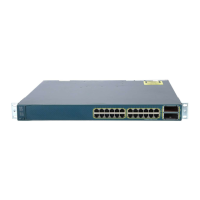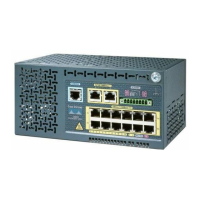17-12
Catalyst 3750 Switch Software Configuration Guide
78-16180-02
Chapter 17 Configuring STP
Configuring Spanning-Tree Features
VLAN-Bridge Spanning Tree
Cisco VLAN-bridge spanning tree is used with the fallback bridging feature (bridge groups), which
forwards non-IP protocols such as DECnet between two or more VLAN bridge domains or routed ports.
The VLAN-bridge spanning tree allows the bridge groups to form a spanning tree on top of the individual
VLAN spanning trees to prevent loops from forming if there are multiple connections among VLANs.
It also prevents the individual spanning trees from the VLANs being bridged from collapsing into a
single spanning tree.
To support VLAN-bridge spanning tree, some of the spanning-tree timers are increased. To use the
fallback bridging feature, you must have the enhanced multilayer image installed on your switch. For
more information, see Chapter 38, “Configuring Fallback Bridging.”
Spanning Tree and Switch Stacks
These statements are true when the switch stack is operating in PVST+ or rapid-PVST+ mode:
• A switch stack appears as a single spanning-tree node to the rest of the network, and all stack
members use the same bridge ID for a given spanning tree. The bridge ID is derived from the MAC
address of the stack master.
• When a new switch joins the stack, it sets its bridge ID to the stack-master bridge ID. If the newly
added switch has the lowest ID and if the root path cost is the same among all stack members, the
newly added switch becomes the stack root.
• When a stack member leaves the stack, spanning-tree reconvergence occurs within the stack (and
possibly outside the stack). The remaining stack member with the lowest stack port ID becomes the
stack root.
• If the stack master fails or leaves the stack, the stack members elect a new stack master, and all stack
members change their bridge IDs of the spanning trees to the new master bridge ID.
• If the switch stack is the spanning-tree root and the stack master fails or leaves the stack, the stack
members elect a new stack master, and a spanning-tree reconvergence occurs.
• If a neighboring switch external to the switch stack fails or is powered down, normal spanning-tree
processing occurs. Spanning-tree reconvergence might occur as a result of losing a switch in the
active topology.
• If a new switch external to the switch stack is added to the network, normal spanning-tree processing
occurs. Spanning-tree reconvergence might occur as a result of adding a switch in the network.
For more information about switch stacks, see Chapter 5, “Managing Switch Stacks.”
Configuring Spanning-Tree Features
These sections describe how to configure spanning-tree features:
• Default Spanning-Tree Configuration, page 17-13
• Spanning-Tree Configuration Guidelines, page 17-13
• Changing the Spanning-Tree Mode., page 17-14 (required)
• Disabling Spanning Tree, page 17-15 (optional)
• Configuring the Root Switch, page 17-16 (optional)
